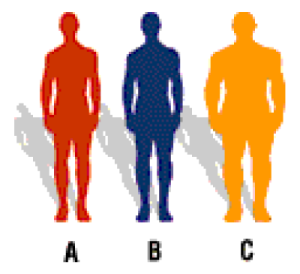This is a sample
This assessment includes a number of measurements giving you an in-depth look at your body composition. You and your health professional will us this this analysis to assess your current health, risk for serious preventable disease, and to develop a fitness and nutrition program that, over time, will reduce risk.
Why Check Body Composition?
Professionals use body composition analysis to measure increased risk for serious disease including hypertension, type II diabetes, dyslipidemia, prostate cancer, stroke, breast cancer, gallbladder disease, colon cancer, osteoarthritis, coronary heart disease, sleep apnea and respiratory problems.
Athletes use body composition to fine-tune their performance.
You can use these measurements to track progress toward achieving your fitness goals.
Weight Alone Can Be Deceiving.
 Proper fitness goals can be best achieved with increased physical activity and sensible diet over an extended period of time. Weight loss without appropriate exercise can actually increase the percent of body fat, and your risk for disease.
Proper fitness goals can be best achieved with increased physical activity and sensible diet over an extended period of time. Weight loss without appropriate exercise can actually increase the percent of body fat, and your risk for disease.
Appearances can be deceiving. Men A, B and C are exactly the same height. A and B have the same weight, and C weighs considerably more. For his height C appears to be fat. But after analyzing body fat levels, B and C have acceptable percentages with A has above the recommended range and is at higher health risk.
Percent Body Fat (FAT%)
Body fat is vital to daily body functions. It cushions the joints and protects the organs, helps regulate body temperature, stores vitamins and helps the body sustain itself when food is scarce. However, serious health risks have been associated with both too much and too little body fat. Plot your current Body Fat Percent according to your age and gender. Body fat percentages above the Healthy range area indicates increased risk for preventable disease.
Your Body Fat % is: 0.00%
Health Risks
Too Little Body Fat – It’s possible to have too little body fat. Women athletes involved in high performance sports that emphasize low body weight and extremely low body fat percentage often experience a decrease in hormones that causes an interruption in the menstrual cycle. The same condition can occur when a women is anorexic and her body goes into a semi-starvation mode. Over an extended period of time, this can lead to other health risks such as the loss of bone mass.
 Too Much Body Fat – Obesity has become a serous health threat for women at every stage of life. Conditions that are attributed to overweight and that are female-specific include an increased incidence of breast cancer after menopause particularly for women taking hormone replacement therapy, and higher rates of endometrial cancer. Also associated with obesity are various birth defects, obstetric and gynecological complications, and infertility. In addition, obesity has been documented in connection with stress incontinence among women.
Too Much Body Fat – Obesity has become a serous health threat for women at every stage of life. Conditions that are attributed to overweight and that are female-specific include an increased incidence of breast cancer after menopause particularly for women taking hormone replacement therapy, and higher rates of endometrial cancer. Also associated with obesity are various birth defects, obstetric and gynecological complications, and infertility. In addition, obesity has been documented in connection with stress incontinence among women.
Fat Free Mass (FFM) and Fat Mass (FAT MASS)
Fat Free Mass is your weight excluding all body fat. It includes the weight of bone, muscle tissue and water. This is the part of your body you want to preserve or expand. Fat Mass includes all body fat. Female bodies require a higher percentage of fat to be healthy.
Your Fat Mass is: 0.00 lbs.
Your Fat Free Mass/Lean Mass is: 0.00 lbs.
What is BMI?
BMI stands for Body Mass Index. It is a number that shows body weight adjusted for height. BMI can be calculated with simple math using inches and pounds, or meters and kilograms. For adults aged 20 years or older, BMI falls into one of these categories:
BMI correlates with body fat. The relation between fatness and BMI differs with age and gender. For example, women are more likely to have a higher percent of body fat then men for the same BMI. On average, older people may have more body fat than younger adults with the same BMI.
Your current BMI measurement is: 23.93
Your Resting Metabolic Rate
There is one basic truth to weight loss. You need to burn more than you eat. The following results of your test show you precisely how many calories your body actually burns at a resting state.
Your current RMR is: (No RMR Data)
Your normal RMR should be: 1888
Fast Metabolism: People with fast “metabolic” rates burn more calories than normal.
Slow Metabolism: People with slow metabolic rates burn less calories than normal.
Source: Tanita Corporation of America, Inc., Korr Medical Technologies, Inc.













